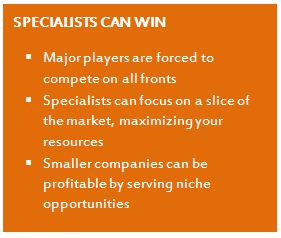CEO Blog - Advice for CEOs on growth and scaling
Maximizing Your Position In Your Market

Every company must develop a strategic direction that best fits its capabilities and its standing in its marketplace. Most business categories fall into similar market share patterns. There are three major players who, combined, have roughly 70-90% of the market. Then you have a group of small savvy specialists that have identified an underserved audience within the market. These tend to be businesses that succeed based on lower volumes, by definition, but much higher margins. In general, they tend to have no more than 5% of the market each. And, finally, you have the remaining companies in the category that live on the crumbs that are left over.

Where Do You Fit?
Understanding where you company falls within this structure will help you develop your most effective strategies. As a major player, you are forced to compete on all fronts in the market. You must provide products or services to all audiences, fight with your competitors on price, packaging, distribution, level of advertising spend, etc. But as a specialist, you have identified a product offering, or audience segment, or geographic area in which to conduct your business. Consciously focusing on a slice of the market, instead of the market as a whole, gives you the flexibility of maximizing your resources.
You can accomplish your sales objectives by addressing a growing demographic, or a growing region of the country, or by providing a service that the larger players don’t offer, or don’t want to offer because the upside isn’t large enough for them. A $100 million business may not be deemed large enough for companies looking to create $1 billion revenue streams, but it can be a very profitable business for the right specialty company.
Avoid Competing Head to Head with Majors
Competing head to head with a major player can be a real danger for a niche company. The inappropriate conclusion that “we can compete against the big boys”, can lead you to either joining those that eat the crumbs, or can put you out of business. Too often, management sees the success enjoyed by their specialty company and pushes itself to broaden their product offerings, or their demographic target or their geographic footprint. What follows can be an expansion of production capabilities, combined with buying your way into the market segment, and realizing substantially lower margins. You are now faced with lower volume than your larger competitors and a lower margin than you can sustain. This is a formula for extinction.
 Identifying the pain points that exist for customers in the market can be sufficient to give your business the competitive edge. Tie breakers can range from better customer service and longer customer service hours to showing flexibility in delivery schedules and billing clients on a more convenient day of the month. Learning these tie breakers in the mind of the customer can win business for a specialist when all other variables appear to be equal to the purchasing department.
Identifying the pain points that exist for customers in the market can be sufficient to give your business the competitive edge. Tie breakers can range from better customer service and longer customer service hours to showing flexibility in delivery schedules and billing clients on a more convenient day of the month. Learning these tie breakers in the mind of the customer can win business for a specialist when all other variables appear to be equal to the purchasing department.
Uniqueness is an Advantage
Niche players also enjoy the advantage of having a minimum of substitutability for their products. By satisfying a very specific need in the market, your customers cannot go elsewhere. If your company is the only supplier, or one of a few suppliers of a service or product, customers and prospects cannot take their business elsewhere. This advantage will allow you to concentrate on innovation, and not have to fight day to day with the other companies serving the same market segment. It is tough to find a substitute for Tabasco® sauce when you are cooking. All that company needed to do was to innovate and add new flavors to the original one.
Creating marketing strategies to support your specialist role will help you to continue your growth, drive innovation and keep you away from the fray with the behemoths that dominate your category. Let them continue to spend on broad-based marketing tactics while you continue to focus on your segment.
Topics: Corporate Strategy, CEO Strategies, Business Growth Strategy, CEO Marketing Vision, Strategic Insights, Pricing, Market Position
Mon, Sep 26, 2011Related Articles

- Press Releases
- Careers
- Case Studies
- Marketing Consultant Company
- Marketing Strategy Consultants
- Marketing Plan Consultants
- B2B Marketing Consultants
- Virtual CMO
- Marketing Consultant Outsourcing
- Fractional CMO
- What is a Fractional CMO
- Healthcare Marketing Consultant
- Marketing Consultant Houston TX Texas
- Marketing Consultant Texas TX
- Marketing Consultant Bay Area
- CEO Blog
- Ebooks Plus
- Executive Marketing Consultants
- Product Marketing Consultants
- B2C Marketing Consultants
- Virtual Marketing Consultants
- Senior Marketing Consultants
- Temporary CMO
- Hire a CMO
- Fractional CMO Salary
- Fractional CMO Responsibilities
- Marketing Consultant Austin TX Texas
- Marketing Consultant Dallas TX Texas
- Marketing Consultant San Antonio
- Helping Private Equity
- Private Equity Blog
- Leadership Team
- Privacy Policy
- Business Marketing Consultants
- Strategic Marketing Consultants
- Marketing Technology Consultants
- Sales and Marketing Consultants
- CMO Job Description
- CMO Salary
- Fractional CMO Agency
- Fractional CMO Services
- CPG Marketing Consultant
- Marketing Consultant San Diego
- Partners
Houston, TX 77056
© 2023 Chief Outsiders

